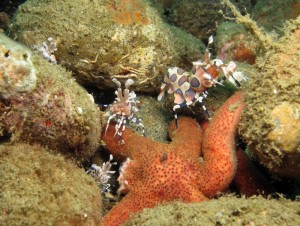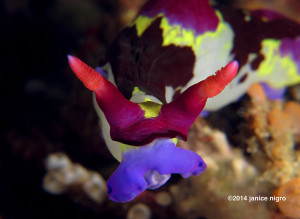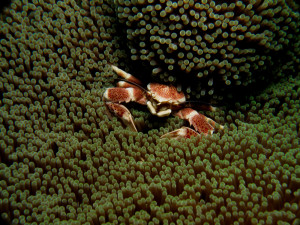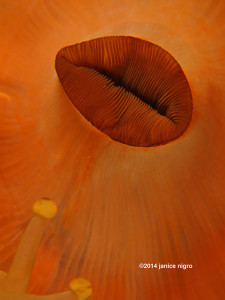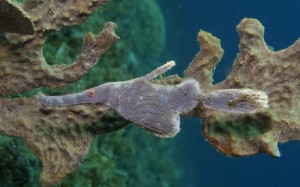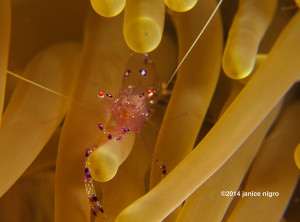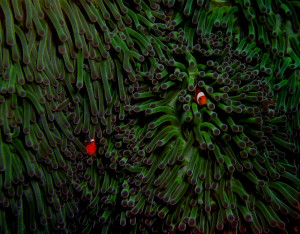Photo / Video News & Reviews
Scuba Diving Made Me An “Artist”
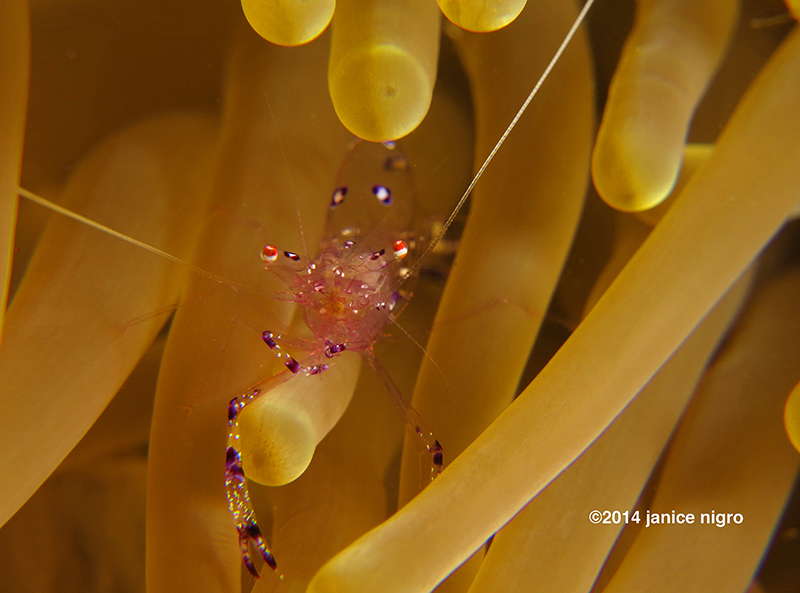
I never took a photo until I went underwater. And when I did, it was a last minute decision. I was on my way to LAX about three hours before my flight to Nadi, Fiji eight years ago, when I stopped by Samy’s Camera in Los Angeles to purchase a camera, but for taking landscape and people photos. I had finally decided that maybe I should take some photos to show people where I was going because the dive destinations were exceptionally beautiful and different. My sales guy made some suggestions based on my initial intentions. Then I offhandedly remarked that I wanted a camera that I could get an underwater housing for…some day. I really was not thinking about buying one at that moment. He immediately changed tack and suggested another camera all together. Then I thought well I am on my way to Fiji, to scuba dive in fact, maybe I should get the housing? It was kind of one of those “no duh” moments. I bought the housing, and it was the best use of 600 USD ever.
I had no clue what I was doing, and my first trip photos underwater were pretty terrible-blue and blurry. Some were good enough though to impress my family who were skeptical about scuba diving in general. “Really, you see that stuff under water?” I started to pay attention to underwater photos in magazines and wherever I could look. And then I started to do a little better. On my first trip to Indonesia, we had a small contest on the boat and my cleaner shrimp photo won! Based on what I saw and read, I started to think that I wanted a real machine, a DSLR. On a layover in Singapore just before another diving trip, I got some terrific underwater photography advice from the shop owner of ScubaCam. He told me that I had limited knowledge about how to use any camera let alone one underwater so he suggested that I stick with my mini-set up but add a strobe. The man opted not to sell me an expensive rig and instead spent 1.5 hours showing me how to set up just the strobe and arms.
The strobe alone, an Inon Z240, made a spectacular difference. All I had was a compact Canon. It was your basic point and shoot-nothing fancy and not a lot of pixels (from 2006!). Ironically, one of my favorite photos ever is one that I took on my first day shooting with the strobe. But there were no manual options on my camera. Frankly, I had not really considered manual options before going to ScubaCam, but the owner had suggested that I stick with my simple camera for underwater and purchase a good DSLR to use topside in order to become familiar with photographic technique. This strategy was a good one because I started to learn about aperture, shutter speed, ISO, and composition.
It took the impetus of another imminent trip to push me to upgrade my equipment. There I was again in a shop deciding, maybe a week beforehand this time, to buy a Canon G10. A point and shoot with manual functions, raw files, and great optics, but it was small so it was easy to travel and dive with. It was a rush, but the Canon underwater housing arrived just before I took off.
I was somewhat frustrated learning to use this new camera (and very nervous to take it underwater the first time – I did take the empty housing down on the first dive), but I managed with the help of a cruise director who was also a photographer. Once I figured out what some of the nuances of the camera were, I was shooting all over the place. She sat with me each night to throw out the bad photos and tell me why the good ones were good. She mentioned that my strobe was top of the line, so that when I was ready to graduate to a fancier rig (or anything), I could keep it.
I still have that camera with the original housing. The problem with the Canon housings is that although they work fine as long as you take care of them and change the o-ring periodically, eventually the springs for the buttons no longer spring anymore, especially under pressure. You will find yourself at 20 meters, and after taking a photo, the button will not release. You have to ascend a bit then to release the pressure on the button in order to take more photos. Probably springs become less springy even in the best of housings, but Canon considers these housings to be disposable so at some point you might have to chuck the whole rig, just because you can no longer get a housing for your “old” camera.
That digital cameras become quickly outdated is a source of stress with underwater photography. Cameras change exceedingly rapidly so that your new camera is really pretty old within a few months even. It takes time for underwater housings to catch up to newer models as it is, but then once the next model in the series comes out, the housings are no longer produced. Replacing one or the other then is time sensitive. My last trip with my G10 after four years was in Bali where the black sand is very fine. It became lodged under the o-rings of the buttons. It is not possible to have it removed so I was forced to purchase not only a new housing but a new camera as well. I still felt that I had a lot to learn, so I bought the Canon G15, but invested in a good housing. I also decided to get a second strobe. I am able to change manual functions more easily with the Nauticam housing, and its construction also protects the o-ring from sand a bazillion times better, so overall it is an easier set up to use than the less expensive Canon housings.
Although technically my photos are reasonably good, I am still working on composition. Composition is the toughest part of underwater photography – making a photo that is not only technically correct but artistic as well. Inspiration is everywhere underwater even if you thought you had absolutely no right brain activity whatsoever. But there are additional considerations.
Underwater photography is like a whole other sport. You need buoyancy control like you never thought before. Time is a factor, and animals move and so do you. As I read and looked at photos in magazines and on websites, I started to see what people could do with the kind of equipment that I had. I learned about wet lenses. A wet lens is added to the outside of a housing in order to magnify your macro subjects. These lenses can be stacked, i.e. one screwed into another, so that you can get super macro photos. I now have two. There are wide-angle wet lens options. I have tried one, but got poor results with it.
Personally I think you can take a great photo with any compact now, especially if you have a strobe, because the resolution and focusing capabilities get better and better with advancing technology. But there are some frustrating aspects. The main one is that there is a significant shutter lag. Clicking to take the photo is not in sync with when the shutter actually opens. So a fish that is moving is particularly difficult to photograph. Furthermore there is a lag for when the photo is transferred/saved to the card so that the camera is slow to take a subsequent photo.
The second dilemma is that you have to be physically extremely close to animals to get good macro shots. It is sort of a rule of macro photography, but with a dedicated macro lens you can be close but not so close so as to disturb the animal. Finally, the focus resolution is great with many of these cameras, but it can never reach the level of a DSLR. The main advantage, however, is that all of the equipment packs up into my backpack.
A couple of other equipment unrelated strategies will help to improve your skills. One is that you do not have to take a photo of every creature that you see. One photographer told me to try to focus on a few specific subjects during a dive – not many all at once. If you focus on a few subjects, you can test different angles, exposures, or lighting techniques so that one might give a desirable result. You start to become a photographer, not just a tourist underwater.
When you are first learning, practice on anything. Nudibranchs are easy, and even some of the more common ones can give striking photos if you become acquainted with some simple techniques. Tunicates, corals, and sponges are all great subjects because of colors and textures, so that when you do have a more challenging subject, you will be prepared. I can still be slow, but I stick with my three to five shots rule if others are waiting and move on or go to the back of the line. Sometimes circumstances prohibit any chance of a good photo anyway so just have a look. I remind myself constantly that it is most important to see the critters.
With a compact camera, it does take more effort sometimes. I have found it to be more time consuming to set up for the photo especially if something is a little off with your first shot, and you are under pressure to move on because of other divers or decompression. Muck diving is a type of diving that offers rewarding photographic opportunities everywhere. There are always creatures to see so that even if the guide spots something really rare, you can spend your time photographing something else while you wait your turn to see it.
As an underwater photographer, I am exceedingly conscious of where my body is underwater. I have seen very nice people, who were good photographers even, but completely ignorant of their location underwater. If I can not take the photo without banging into or moving something, I do not. It is a privilege to see these animals and be in their world. A few good photos are better than a lot of poor ones which you will get regardless because of the nature of the “sport”.
Sometimes I have mixed feelings about underwater photography because you may spend more time photographing than looking around you! Once I missed a whale shark that did a “swim-by” because I was behind taking photos. I have also felt frustration because others may seem to hog time in front of critters. The last time I felt that I thought if that happens again then the whole rig goes in the garbage because diving is for removing yourself from the conventional world. If you have a philosophical view, there will be no poor feelings underwater. I have since become more focused on the process and not necessarily the end product.
I still have not figured out how to take time to create an artistic photo and keep up with the guide. It must be terribly tedious for them to watch someone taking photos, and a buddy once without a camera expressed deep anger in not wanting to hang around while I did that. The most obvious dilemma that is unique to the sport is that I cannot be underwater all of the time. It truly helps to photograph subjects topside, however. Composition for example is a universal principle.
Scuba diving is a reason to travel, to be physically active, and to create art. Sometimes I get a desirable result, sometimes unexpectedly, but mostly I have the kind of peace that taking up an art form can give you, and I discovered it through scuba diving.
©2014 Janice Marie Nigro/janikiInk.com
Blogs
Diver Discovering Whale Skeletons Beneath Ice Judged World’s Best Underwater Photograph
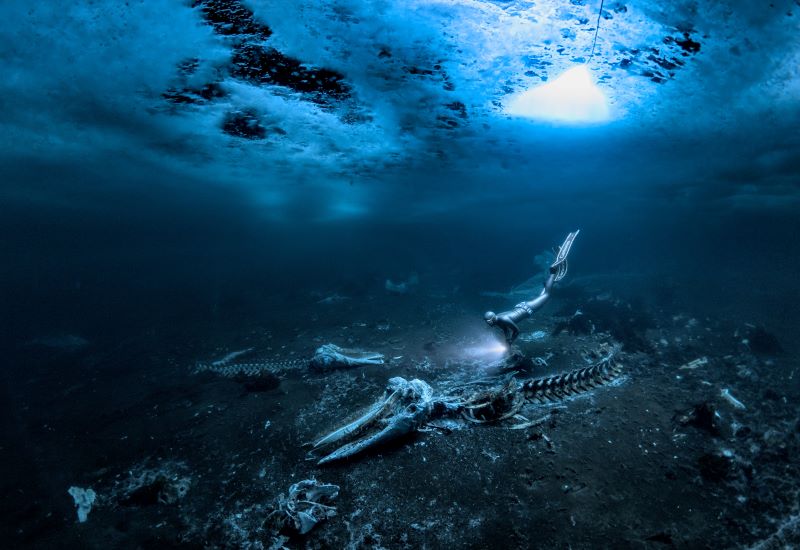
An emotive photograph showing a freediver examining the aftermath of whaling sees
Alex Dawson from Sweden named Underwater Photographer of the Year 2024. Dawson’s
photograph ‘Whale Bones’ triumphed over 6500 underwater pictures entered by underwater
photographers from around the world.
“Whale Bones was photographed in the toughest conditions,” explains chair of judging
panel Alex Mustard, “as a breath-hold diver descends below the Greenland ice sheet to bear
witness to the carcasses. The composition invites us to consider our impact on the great
creatures of this planet. Since the rise of humans, wild animals have declined by 85%. Today,
just 4% of mammals are wildlife, the remaining 96% are humans and our livestock. Our way
needs to change to find a balance with nature.”
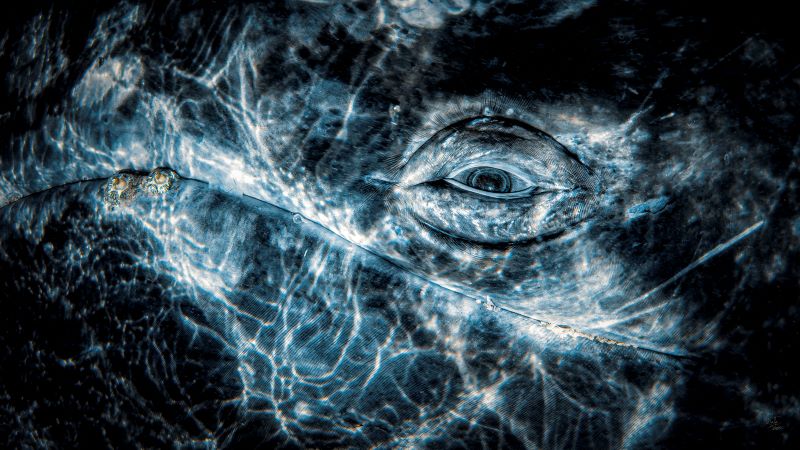
Photo: Rafael
Fernandez Caballero
Whales dominated the winning pictures this year with Spanish photographer Rafael
Fernandez Caballero winning two categories with his revealing photos of these ocean giants:
a close up of a grey whale’s eye and an action shot of a Bryde’s whale engulfing an entire bait
ball, both taken in Magdalena Bay, Baja California, Mexico. Fernandez Caballero took ‘Grey
Whale Connection’ while drifting in a small boat, holding his camera over the side in the water
to photograph the curious whale. ‘The End Of A Baitball’ required Fernandez Caballero to dive
down and be in exactly the right place at the moment the whale lunged. “The photo shows
the high speed attack,” he said, “with the whale engulfing hundreds of kilograms of sardines
in one bite — simply unforgettable to see predation on such a scale.”
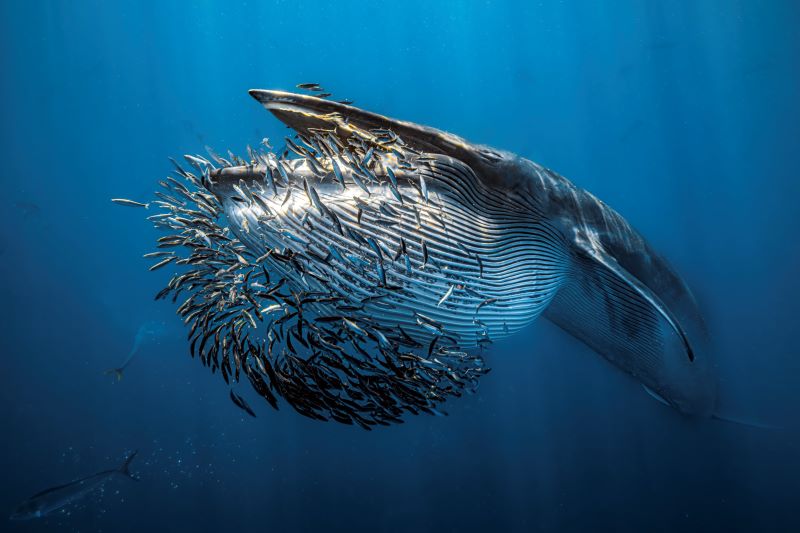
Photo: Rafael
Fernandez Caballero
Lisa Stengel from the United States was named Up & Coming Underwater Photographer of the Year 2024 for her image of a mahi-mahi catching a sardine, in Mexico. Stengel used both a very fast shutter speed and her hearing to catch the moment. “If you listen there’s an enormous amount of sound in the ocean,” she explained. “The action was too fast to see, so I honed in on the sound of the attacks with my camera to capture this special moment.”
“It is such an exciting time in underwater photography because photographers are capturing such amazing new images, by visiting new locations and using the latest cameras,”
commented judge Alex Mustard. “Until this year I’d hardly ever see a photo of a mahi mahi,
now Lisa has photographed one hunting, action that plays out in the blink of an eye.”
The Underwater Photographer of the Year contest is based in the UK, and Jenny Stock,
was named as British Underwater Photographer of the Year 2024 for her image “Star
Attraction”, which finds beauty in species of British wildlife that are often overlooked.
Exploring the west coast of Scotland, Stock explained “in the dark green depths my torch
picked out the vivid colours of a living carpet of thousands of brittle stars, each with a
different pattern. I was happily snapping away, when I spotted this purple sea urchin and I
got really excited.”
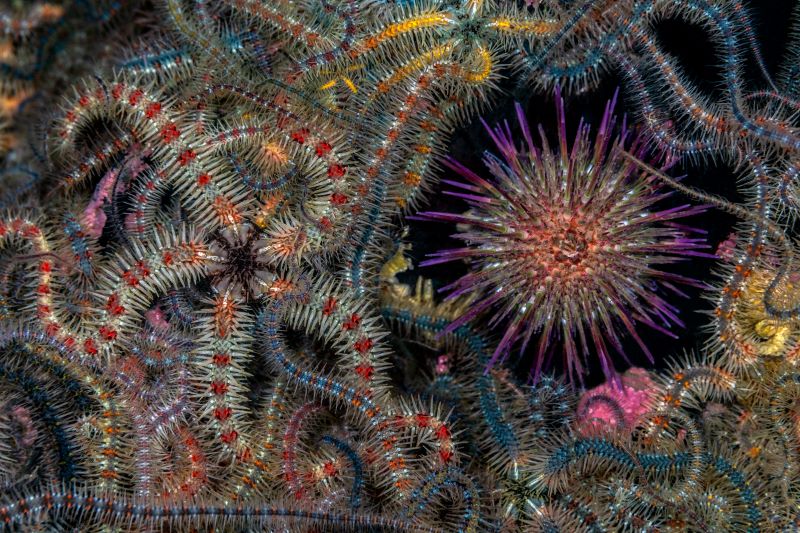
Photo: Jenny Stock
In the same contest, Portuguese photographer, Nuno Sá, was named ‘Save Our Seas
Foundation’ Marine Conservation Photographer of the Year 2024, with his photo ‘Saving
Goliath’, taken in Portugal. Sá’s photo shows beachgoers trying to save a stranded sperm
whale. The picture gives us hope that people do care and want to help the oceans, but also
warns us that bigger changes are needed. “The whale had been struck by a ship and its fate
was sealed,” explains Sá. “An estimated 20,000 whales are killed every year, and many more
injured, after being struck by ships-and few people even realise that it happens.”
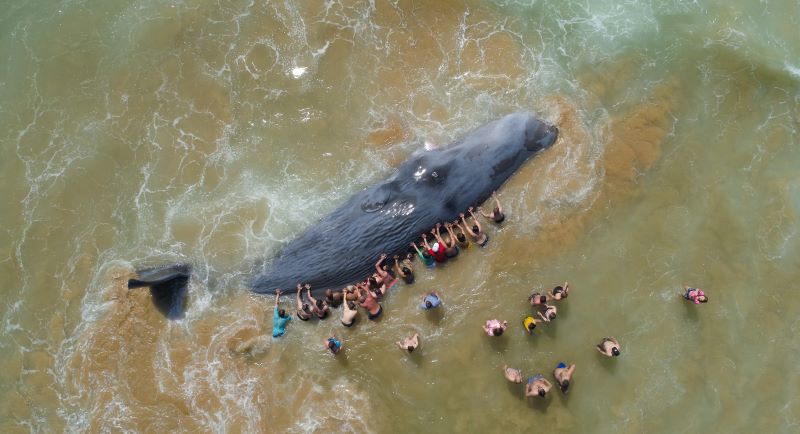
Photo: Nuno Sá
More winning images can be found at www.underwaterphotographeroftheyear.com.
About Underwater Photographer of the Year
Underwater Photographer of the Year is an annual competition, based in the UK, that celebrates photography beneath the surface of the ocean, lakes, rivers and even swimming pools, and attracts entries from all around the world. The contest has 13 categories, testing photographers with themes such as Macro, Wide Angle, Behaviour and Wreck photography, as well as four categories for photos taken specifically in British waters. The winners were announced in an award ceremony in Mayfair, London, hosted by The Crown Estate. This year’s UPY judges were experienced underwater photographers Peter Rowlands, Tobias Friedrich and Dr Alexander Mustard MBE.
Header image: Underwater Photographer of the Year 2024 winner Alex Dawson
News
World’s Best Underwater Photographers Unveil Breathtaking Images at World Shootout 2023
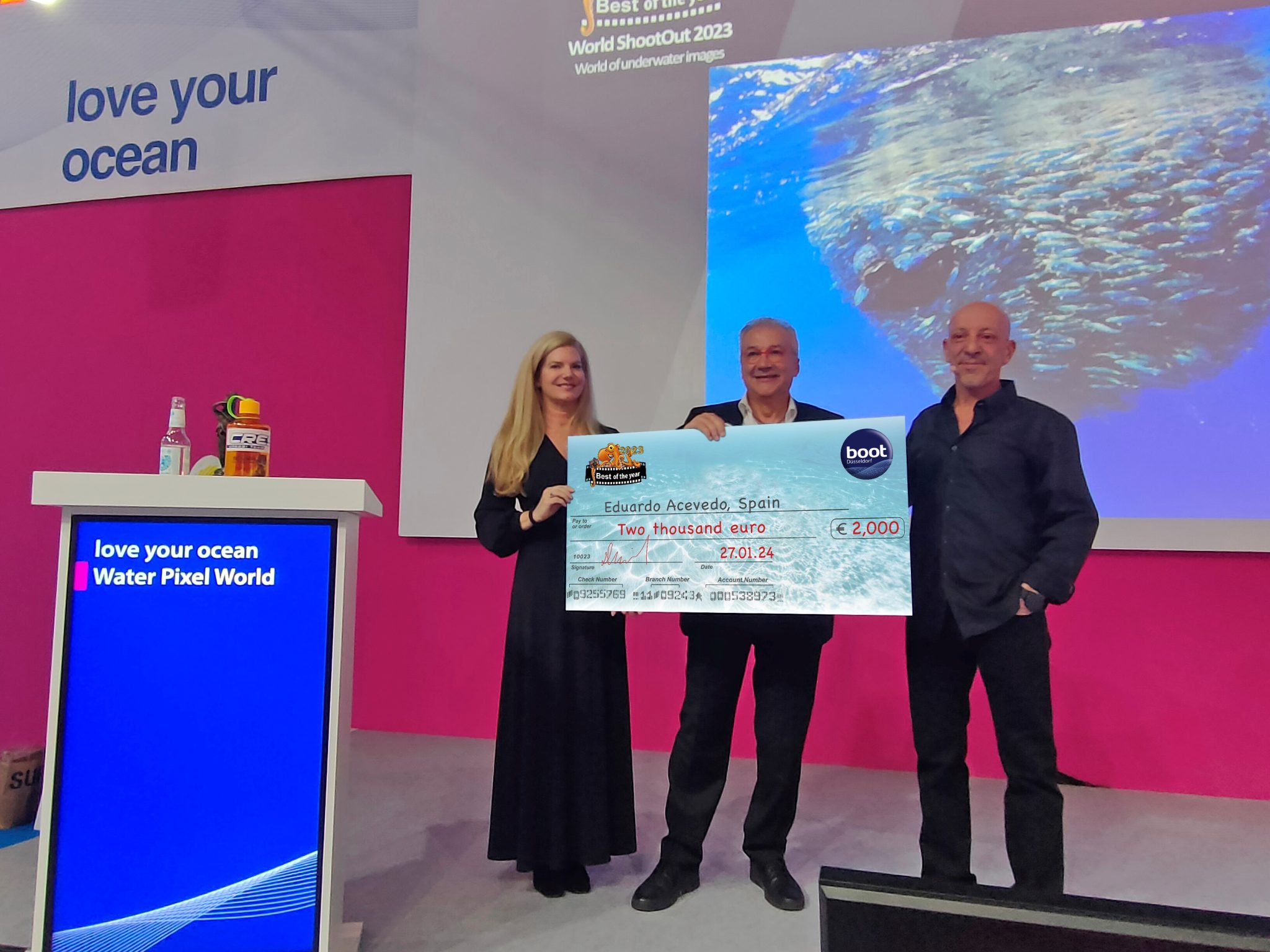
The winners of the prestigious World Shootout 2023 underwater photography competition were announced at this year’s BOOT Show, captivating audiences at the world’s largest diving and water sports exhibition in Dusseldorf, Germany. Hundreds of photographers from 54 countries competed across nine categories, pushing the boundaries of creativity and technical skill.
Grand Prize Winners
- Picture of the Year: Spanish photographer Eduardo Acevedo “secured” the top Honor with the prestigious prize the “boot Dusseldorf Director’s Prize, earning an Andromeda statuette and a €2,000 cash prize.
- Best 5 Images Portfolio: Luc Rooman from Belgium triumphed in this category, winning a dream 4-week diving trip for two to Papua New Guinea, valued at $18,900.
- Amateur Photographer: Alexandra Ceurvorst from the USA impressed the judges with her talent, taking home the 1,000 € cash prize award.
Celebrating Diversity and Innovation
This year’s competition saw 11,680 entries from 964 photographers, showcasing a remarkable spectrum of skills and perspectives. From the intricate wonders of Macro photography to the beauty of “Black Water”, the “Underwater Fashion” category added a touch of artistry and innovation, while the ever-important ” Environmental & Conservation” category served as a powerful reminder of the need to protect these fragile ecosystems.
Looking Ahead: AI and Ocean Conservation
World Shootout founder and producer David Pilosof unveiled an exciting addition for the 2024 competition: this year the Environmental category will be focusing on the impact of plastic on our oceans and future.
This category will embrace the potential of AI or other editing software as a tool to amplify the conservation message.
Entrants will submit campaigns of three original underwater photographs dealing with plastic pollution, along with their final AI assistance processing. This innovative approach encourages artistic expression while raising awareness about a critical environmental issue.
Explore the Stunning Collection
Discover the complete album of competition entries by clicking here.
For Low-resolution photos of finalist entries in eight categories, click here.
-

 News3 months ago
News3 months agoCapturing Critters in Lembeh Underwater Photography Workshop 2024: Event Roundup
-

 Marine Life & Conservation Blogs3 months ago
Marine Life & Conservation Blogs3 months agoCreature Feature: Swell Sharks
-

 Blogs2 months ago
Blogs2 months agoMurex Resorts: Passport to Paradise!
-

 Blogs2 months ago
Blogs2 months agoDiver Discovering Whale Skeletons Beneath Ice Judged World’s Best Underwater Photograph
-

 Gear Reviews3 weeks ago
Gear Reviews3 weeks agoGEAR REVIEW – Revolutionising Diving Comfort: The Sharkskin T2 Chillproof Suit
-

 Gear Reviews3 months ago
Gear Reviews3 months agoGear Review: Oceanic+ Dive Housing for iPhone
-

 Marine Life & Conservation2 months ago
Marine Life & Conservation2 months agoSave the Manatee Club launches brand new webcams at Silver Springs State Park, Florida
-

 News2 months ago
News2 months agoPADI Teams Up with Wellness Brand Neuro to Drive Ocean Change and Create a Blue State of Mind


